| Columns Retired Columns & Blogs |
maybe this is a dumb question but if the MBL is omnidirectional why would you need to toe them in as shown in the picture?
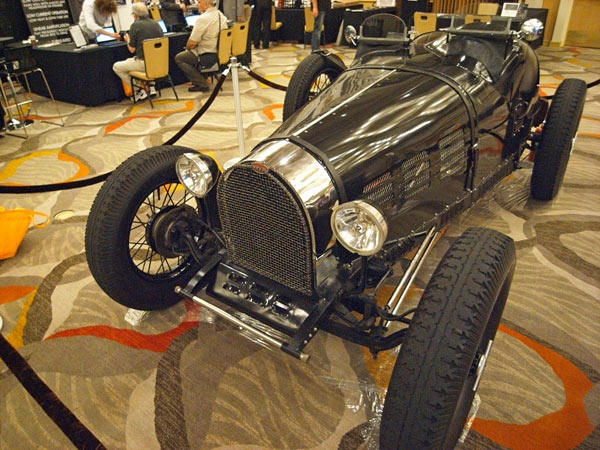
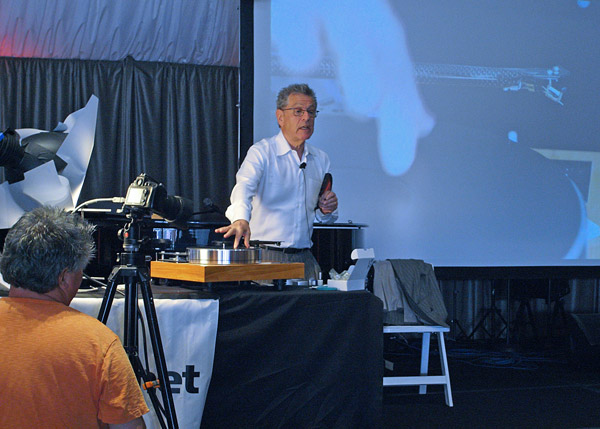
The Pavilion was the venue for the show's "Audio University" seminars, and there I caught Stereophile's and AnalogPlanet.com's Michael Fremer, presenting what the Show Guide listed as "Michael Fremer's World-Renowned Turntable Set-up . . . Watch and Listen while Mr. Fremer sets up a Turntable!" And MIchael did indeed set-up a turntable—a ProJect— including setting the correct stylus overhang, VTA, anti-skating force, and azimuth, and optimal downforce, with every detail projected on a large screen behind him. I take my hat off to Michael for doing in public something I find stressful in private!
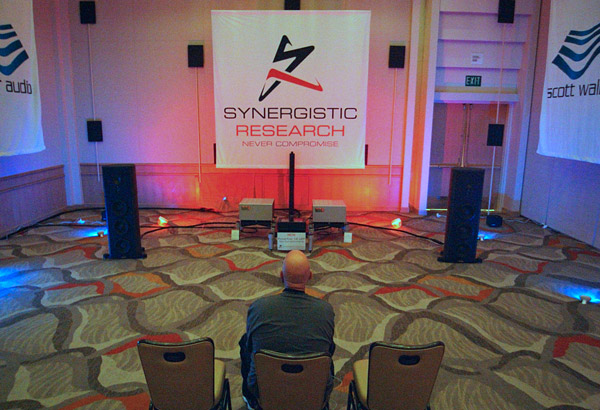
The first audio exhibit I visited was the enormous room—35' by 50' with a 25' ceiling—hosted by Anaheim dealer Scott Walker Audio. Featuring Magico S7 speakers driven by Soulution's 701 monoblocks, 725 preamplifier, and Berkeley Audio Design's new Reference DAC 2, everything was hooked up with Synergistic Research cables and powered from Synergistic's Powercell 12 UEF AC conditioner. But if you look closely at the photo, you can see the black squares—these are the UEF acoustic panels, now marketed by UEF Labs, a separate company from Synergistic, that I wrote about in our 2016 CES report. These don't look large enough or thick enough to have much of an effect on problematic acoustics. I was sitting in the 4th row of seats in the Scott Walker room, well beyond the "critical distance"—the distance where the direct sound of the speakers and the reverberant sound of the room are equal in sound power. However, the Q-Sound effects on a track from Roger Waters's Amused to Death album allowed a stable soundstage to extend a full 180°, well beyond the physical locations of the Magico speakers. This is something that I would not have expected given that the soundfield at my listening position would have been dominated by the room's reverberant field.
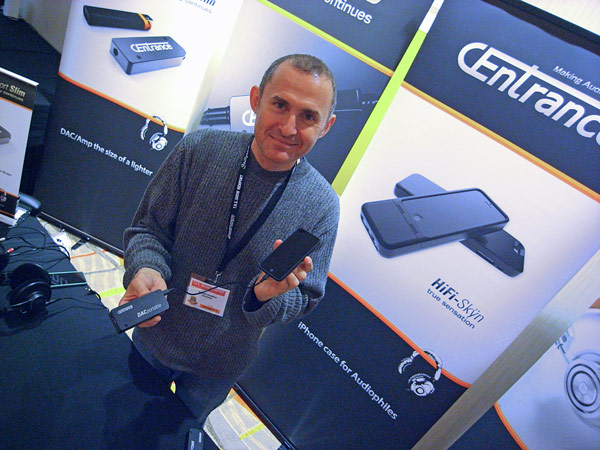
Outside the Scott Walker room, I encountered Centrance's Michael Goodman (above) who showed me the new DACPort HD D/A headphone amplifier. This comes in two versions, the USB bus-powered HD at $199 and a larger battery-powered version ($299), the DACportable, which is based on Centrance's HiFi-Skyn portable dock, that can work with iPhones. Both use an "audiophile-grade," "32-bit compatible" AKM AK4490 D/A converter and offer bit-perfect PCM playback with sample rates up to 384kHz and can also decode DSD data. The Portable also includes EQ.
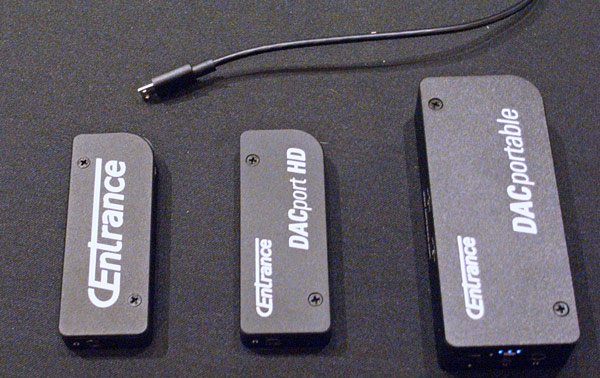
Shown above are (L–R) the Centrance DACport Slim ($99), the DACport HD ($199), and the DACportable ($299).
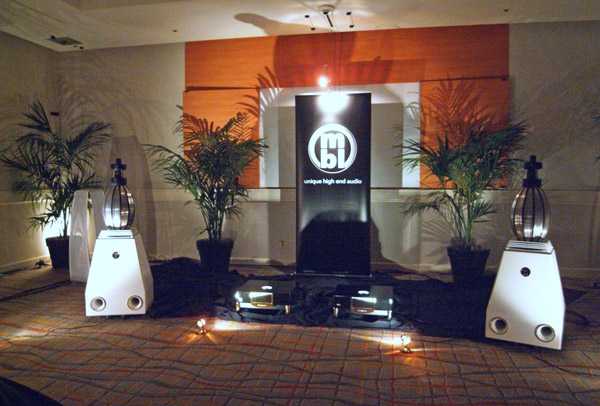
MBL North America's Jeremy Bryan take enormous pains at shows to solve his exhibit room's acoustic issues, and if you at the photo, you can see the coffered ceiling. This required Jeremy to stuff the cavities with magazines and promotional materials, but once that had been done, the sound from the omnidirectional MBL 101E Mk.2 speakers ($70,500/pair) on the Reference Recordings "Lord Make Me an Instrument" was smooth and full-range. The speakers' "radialstrahler" tweeter remains one of my favorites, combining extension with a fatigue-free quality that becomes addictive. Driving the speakers in bi-amped mode were two of MBL's new Noble Line N21 stereo amplifiers (380Wpc into 4 ohms, $16,500 each), which use a second-generation version of the German company's class-D LASA technology, which I first encountered when I reviewed the Corona C15 monoblock in June 2014. Source was MBL's N31 DAC/CD player ($15,400), which has a minimum-phase reconstruction filter. But the strangest demo material award goes to MBL for playing me an arrangement for acoustic guitar ensemble of Queen's "Bohemian Rhapsody."
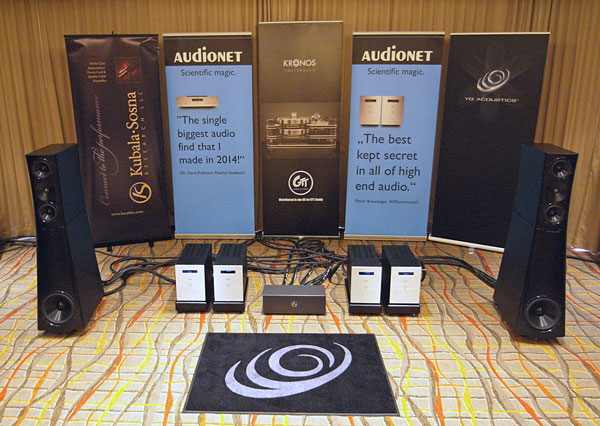
The room from La Jolla dealer ALMA featured familiar speakers—YG's Sonja 1.2 ($72,800/pair—and cables—Kubala-Sosna's Elation! Series—driven by unfamiliar electronics from Audionet: the MAX monoblocks ($30,500/pair), PAM G2 phono stage ($10,100) with EPX power supply ($10,100), all connected to a Kubala-Sosna Expander AC distribution unit ($4800). When I entered a room, a big-band album was being played on the Kronos turntable with Black Beauty tonearm ($50,000) and Air Tight Opus 1 cartridge ($15,000) featuring a vibes and xylophone duo. "I know I know what this is," I thought, "but what is it?" It was Duke Ellington's classic Jazz Party in Stereo and was reproduced with terrific dynamics. The dem continued with the instrumental solos from the second Blood, Sweat & Tears album, which I enjoyed as much as I had with the Ellington album, at least until David Clayton-Thomas started singing. :-)
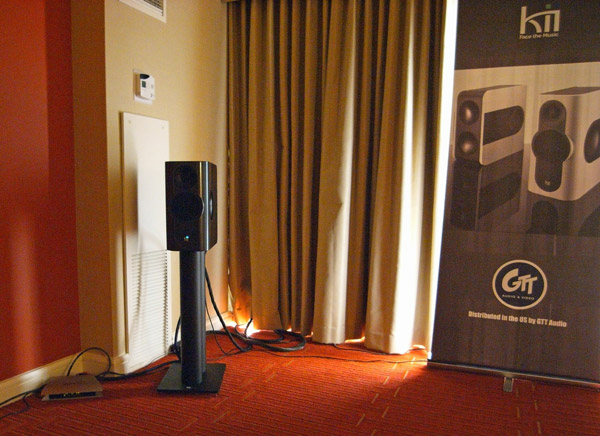
Audionet and Kronos are distributed by New Jersey's GTT Audio and while Sasha Matson has already reported on GTT's 10th floor room, I did want to echo his positive response to the sound of the Bruno Putzeys-designed Kii Three powered speakers ($13,900 pair). The left speaker was fed digital data from a MacBook running Roon via an Auralic Aries streamer, and the right speaker was fed data via a CAT5 cable. The enormous sound on a Joe Bonamassa track featuring acoustic guitar and kodo-style drums belied the physically small size of the speakers.
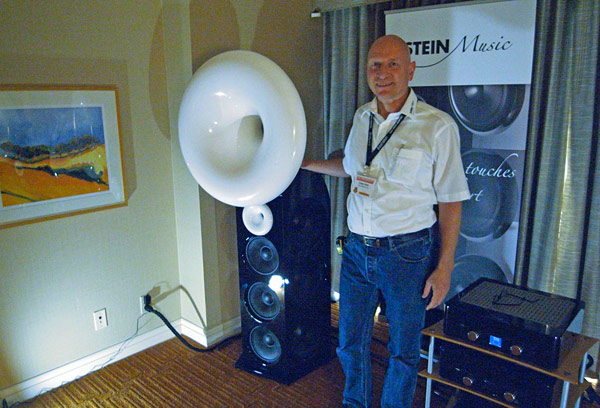
Sasha also reported favorably on the sound of Holger Stein's prototype V6 speakers, which combine a horn midrange covering the range from 500Hz to 3.5kHz with a horn tweeter and open-baffle lower-midrange and bass arrays featuring three 10" Kevlar-cone units and six Kevlar-cone 12" woofers, respectively. The woofers operate below 60Hz and are driven by an internal 450W amplifier and adjusted with DSP to match the room. But, tipped off by the Los Angeles & Orange County Audiophile Society's main man, Bob Levi, I took a listen to these speakers and was blown away by the natural, unforced sound quality of the female soloist on a baroque aria recording.

maybe this is a dumb question but if the MBL is omnidirectional why would you need to toe them in as shown in the picture?

I like Mike already, but he seems so comfortable just being Mike these days. He spread good vibes at the show.
Regarding the MBL's, remember their 11,000 dollar price back in 2000 or so? Price creep is a sad thing.

I was in the front row of the room -- too close, I was later given to understand -- and from where I was, the sound seemed to wrap around 270 degrees! The most convincing demonstration of surround from two channels I've heard heard.
I assume the recording was mixed for surround (crosstalk cancellation/HRTF manipulation), but still, I was impressed and unsure what to attribute the success to -- the size of the room (no early reflections to interfere with the HRTF effects), those strange acoustic panels, or both?
Also thought that Bugatti was the coolest tech at the show. Guess they don't believe in placards . . .

Back in the 90's there used to be a speaker manufacturer who would "wow" prospective buyers with their rather poor speakers using Q-Sound encoded music to demonstrate how well 2-channels could sound "surround".
Sitting in the sweet spot, a good system should be able to envelop the listener in 360-degree sound. "Amused To Death" should at time sound like there are voices originating from behind and horses prancing from front to rear. 180-degrees seems compromised.